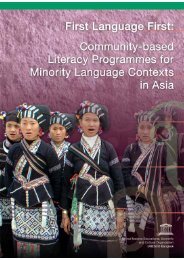Part II.pdf - MTB-MLE Network
Part II.pdf - MTB-MLE Network
Part II.pdf - MTB-MLE Network
Create successful ePaper yourself
Turn your PDF publications into a flip-book with our unique Google optimized e-Paper software.
Community consultation and decision-making during the process of orthography development is<br />
also crucial. The written language is just as much a part of a community’s cultural identity as is<br />
its oral form. In the reports from Bangladesh, Thailand and India, we see that community involvement<br />
in the development of an appropriate writing system was significant. Though time-consuming,<br />
this investment in time inevitably reaps rewards in terms of the community choosing to own and<br />
accept the written form of their language.<br />
The reports reflect that mobilization, recruitment, identification of co-ordinators/supervisors and<br />
training occur most effectively when respected community leaders identify those who will take<br />
significant programme roles.<br />
Literature production approaches<br />
The country report from Thailand outlines in detail the processes involved in the participative<br />
production of teaching and learning materials. Building on a solid foundation of rigorous linguistic<br />
research, the project planners worked carefully together with the community to make appropriate<br />
choices regarding the writing system to be used, and options for representing sounds that had no<br />
parallel in the Thai language. Then, with community participation, stories and texts were written<br />
to both test the writing system and provide reading material for pilot classes. Locally produced<br />
materials or teaching/learning materials that are student generated are more likely to reflect the<br />
context and needs of the learners. Materials that are translated from the national language or materials<br />
that are adapted from other cultural contexts and modified for use in a bilingual literacy programme<br />
should be assessed carefully for their suitability. A review of the country reports shows that both<br />
approaches have been tried within the UNESCO-APPEAL project. As the literacy programmes<br />
continue, it will be helpful for participating countries to evaluate the effectiveness of materials that<br />
they have created.<br />
Links with other agencies and existing programmes<br />
A link between literacy programmes and other development efforts emphasizes the principle of<br />
immediacy in programme design. Adult learners want to be able to use what they have learned to<br />
improve their lives. The report from the Chinese programme among the Lahu shows that there<br />
has been particular thought given to poverty alleviation by structuring the programme to help meet<br />
the economic needs of the participants.<br />
Within the Philippine report, links to established educational assessment programmes are mentioned<br />
that give accreditation to learners. Such recognition is often an incentive for learners to participate<br />
in non-formal education programmes.<br />
Within programme development, contributions from the academic sector (linguists and<br />
anthropologists), universities and other agencies complement the work done at local and government<br />
levels. Within the preliminary baseline research that informs programme development, it is helpful<br />
to analyse the agencies that have a concern/involvement in a community’s language development<br />
activities.<br />
137
















